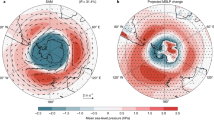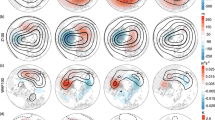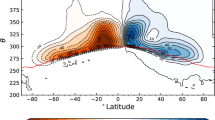Abstract
Heat waves are thought to result from subseasonal atmospheric variability. Atmospheric phenomena driven by tropical convection, such as the Asian monsoon, have been considered potential sources of predictability on subseasonal timescales. Mid-latitude atmospheric dynamics have been considered too chaotic to allow significant prediction skill of lead times beyond the typical 10-day range of weather forecasts. Here we use a 12,000-year integration of an atmospheric general circulation model to identify a pattern of subseasonal atmospheric variability that can help improve forecast skill for heat waves in the United States. We find that heat waves tend to be preceded by 15–20 days by a pattern of anomalous atmospheric planetary waves with a wavenumber of 5. This circulation pattern can arise as a result of internal atmospheric dynamics and is not necessarily linked to tropical heating. We conclude that some mid-latitude circulation anomalies that increase the probability of heat waves are predictable beyond the typical weather forecast range.
This is a preview of subscription content, access via your institution
Access options
Subscribe to this journal
Receive 12 print issues and online access
$259.00 per year
only $21.58 per issue
Buy this article
- Purchase on Springer Link
- Instant access to full article PDF
Prices may be subject to local taxes which are calculated during checkout




Similar content being viewed by others
Change history
30 October 2013
In the version of this Article originally published online, the NOAA CPO's MAPP program was missing from the Acknowledgements. This has been corrected in all versions of the Article.
References
Easterling, D. R. et al. Climate extremes: Observations, modelling, and impacts. Science 289, 2068–2074 (2000).
Ebi, K. & Meehl, G. A. Heatwaves and Global Climate Change, The Heat is On: Climate Change and Heatwaves in the Midwest. Regional Impacts of Climate Change: Four Case Studies in the United States 8–21 (Pew Center on Global Climate Change, 2007).
Meehl, G. A. & Tebaldi, C. More intense, more frequent, and longer lasting heat waves in the 21st century. Science 305, 994–997 (2004).
Madden, R. A. & Julian, P. R. Detection of a 40–50 day oscillation in the zonal wind in the tropical Pacific. J. Atmos. Sci. 28, 702–708 (1971).
Waliser, D. E., Lau, K. M., Stern, W. & Jones, C. Potential predictability of the Madden–Julian oscillation. Bull. Am. Meteorol. Soc. 84, 33–50 (2003).
Branstator, G., Mai, A. & Baumhefner, D. Identification of highly predictable flow elements for spatial filtering of medium- and extended-range numerical forecasts. Mon. Weath. Rev. 121, 1786–1802 (1993).
DelSole, T. & Tippett, M. K. Predictable components and singular vectors. J. Atmos. Sci. 65, 1666–1678 (2008).
Schubert, S., Wang, H. & Suarez, M. Warm seasonal subseasonal variability and climate extremes in the Northern Hemisphere: the role of stationary Rossby waves. J. Clim. 24, 4773–4792 (2011).
Chen, P. & Newman, M. Rossby wave propagation and the rapid development of upper-level anomalous anticyclones during the 1988 US drought. J. Clim. 11, 2491–2504 (1998).
Lyon, B. & Dole, R. M. A diagnostic comparison of the 1980 and 1988 US summer heat wave-droughts. J. Clim. 8, 1658–1675 (1995).
Kalnay, E. et al. The NCEP/NCAR 40-year reanalysis project. Bull. Am. Meteorol. Soc. 77, 437–471 (1996).
Branstator, G. Horizontal energy propagation in a barotropic atmosphere with meridional and zonal structure. J. Atmos. Sci. 40, 1689–1708 (1983).
Hoskins, B. J. & Ambrizzi, T. Rossby wave propagation on a realistic longitudinally varying flow. J. Atmos. Sci. 50, 1661–1671 (1993).
Namias, J. Anatomy of Great Plains protracted heat waves (especially the 1980 US summer drought). Mon. Weath. Rev. 110, 824–838 (1982).
Chang, F.-C. & Wallace, J. M. Meteorological conditions during heat waves and droughts in the United States Great Plains. Mon. Weath. Rev. 115, 1253–1269 (1987).
Plumb, R. A. On the three-dimensional propagation of stationary waves. J. Atmos. Sci. 42, 217–229 (1985).
Karoly, D. J., Plumb, R. A. & Ting, M. Example of the horizontal propagation of quasi-stationary waves. J. Atmos. Sci. 46, 2802–2811 (1989).
Hoskins, B. & Karoly, D. J. The steady linear response of a spherical atmosphere to thermal and orographic forcing. J. Atmos. Sci. 38, 1179–1196 (1981).
Branstator, G. Organization of storm track anomalies by recurring low-frequency circulation anomalies. J. Atmos. Sci. 52, 207–226 (1995).
Branstator, G. Circumglobal teleconnections, the jet stream waveguide, and the North Atlantic Oscillation. J. Clim. 15, 1893–1910 (2002).
Ding, Q. & Wang, B. Circumglobal teleconnection in the Northern Hemisphere summer. J. Clim. 18, 3483–3505 (2005).
Ding, Q., Wang, B., Wallace, J. M. & Branstator, G. Tropical-extratropical teleconnections in boreal summer: Observed interannual variability. J. Clim. 24, 1878–1896 (2011).
Newman, M. & Sardeshmukh, P. D. The impact of the annual cycle on the North Pacific/North American response to remote low-frequency forcing. J. Atmos. Sci. 55, 1336–1353 (1998).
Erich, E. et al. Soil moisture-atmosphere interactions during the 2003 European summer heat wave. J. Clim. 20, 5081–5099 (2007).
Collins, W. D. et al. The Community Climate System Model version 3 (CCSM3). J. Clim. 19, 2122–2143 (2006).
Gent, P. et al. The community climate system model version 4. J. Clim. 24, 4973–4991 (2011).
Acknowledgements
We thank A. Mai for carrying out the experiment and S. Schubert for comments. Portions of this study were supported by the Office of Science (BER), US Department of Energy, NASA NEWS, NOAA CPO's MAPP program and the National Science Foundation. NCAR is sponsored by the National Science Foundation. Computing resources were provided by NCAR’s Computational and Information Systems Laboratory and by the National Energy Research Scientific Computing Center, which is supported by BER of the US Department of Energy.
Author information
Authors and Affiliations
Contributions
H.T. and G.B. led the analysis and all authors contributed to writing of the paper.
Corresponding author
Ethics declarations
Competing interests
The authors declare no competing financial interests.
Supplementary information
Supplementary Information
Supplementary Information (PDF 3101 kb)
Rights and permissions
About this article
Cite this article
Teng, H., Branstator, G., Wang, H. et al. Probability of US heat waves affected by a subseasonal planetary wave pattern. Nature Geosci 6, 1056–1061 (2013). https://doi.org/10.1038/ngeo1988
Received:
Accepted:
Published:
Issue Date:
DOI: https://doi.org/10.1038/ngeo1988
This article is cited by
-
2023: Weather and Climate Extremes Hitting the Globe with Emerging Features
Advances in Atmospheric Sciences (2024)
-
Increased impact of heat domes on 2021-like heat extremes in North America under global warming
Nature Communications (2023)
-
Local mechanisms for global daytime, nighttime, and compound heatwaves
npj Climate and Atmospheric Science (2023)
-
Risks of synchronized low yields are underestimated in climate and crop model projections
Nature Communications (2023)
-
Has Arctic sea ice loss contributed to weakening winter and strengthening summer polar front jets over the Eastern Hemisphere?
Climate Dynamics (2023)



